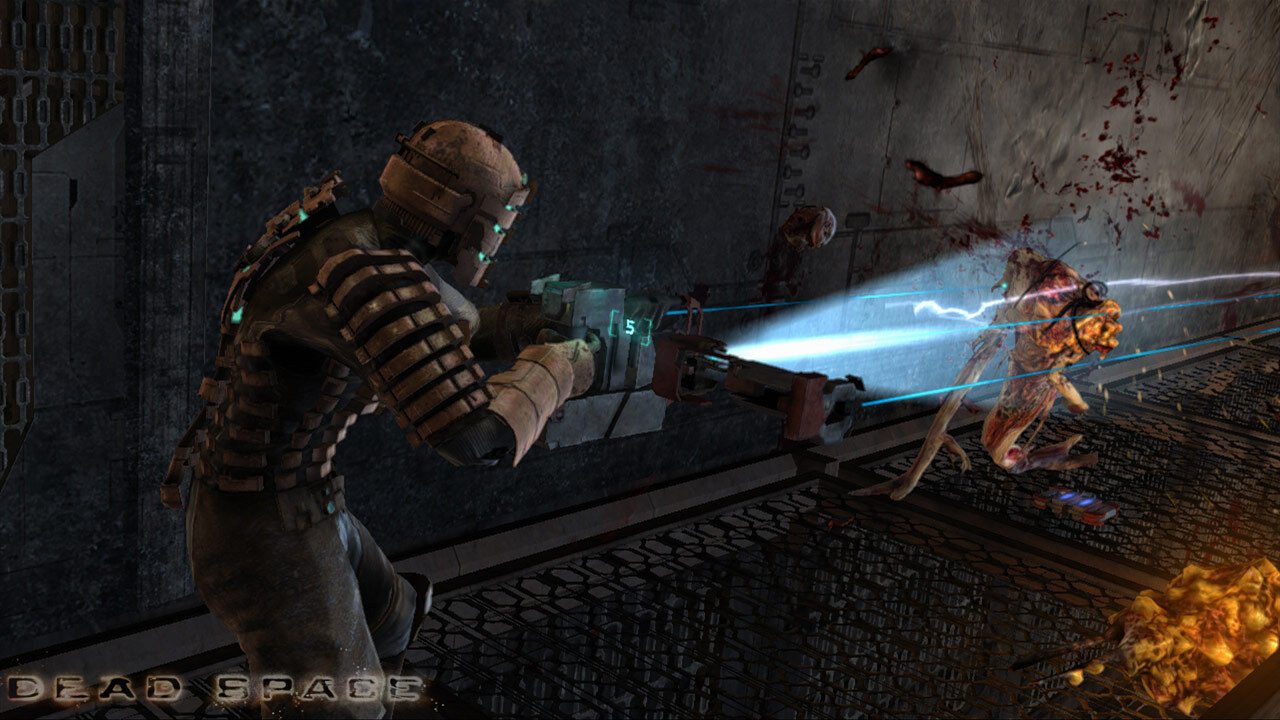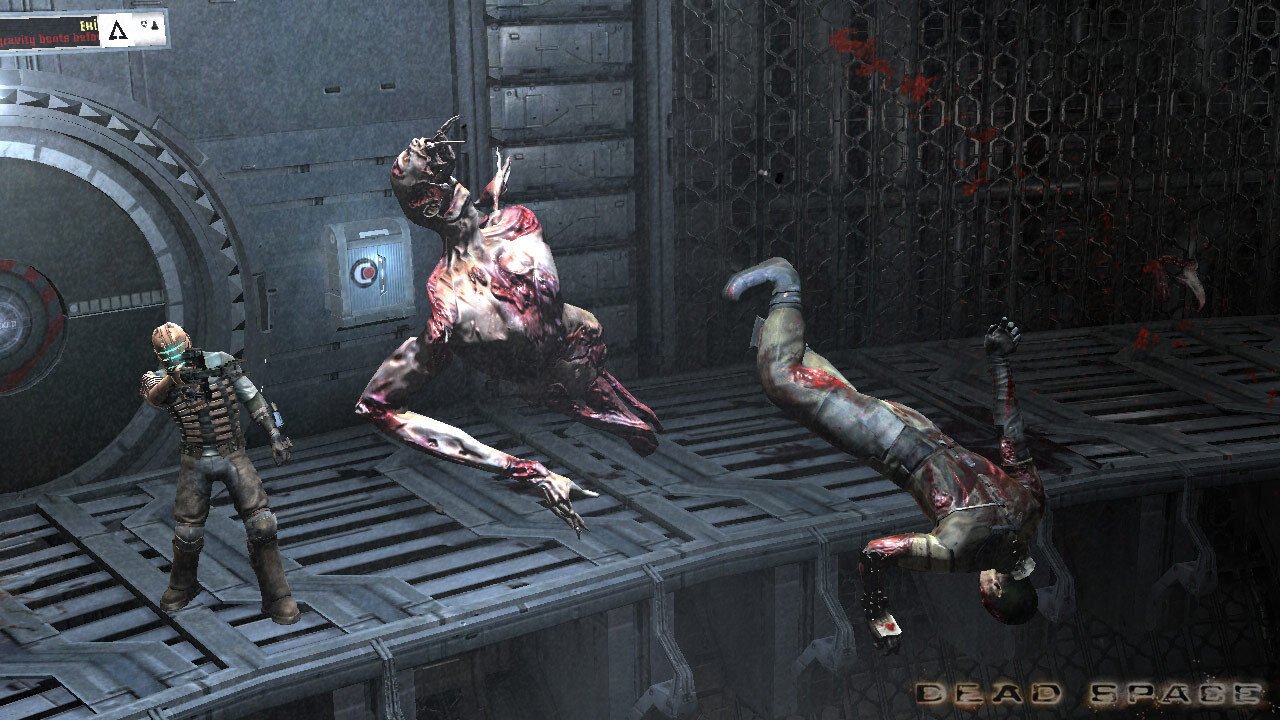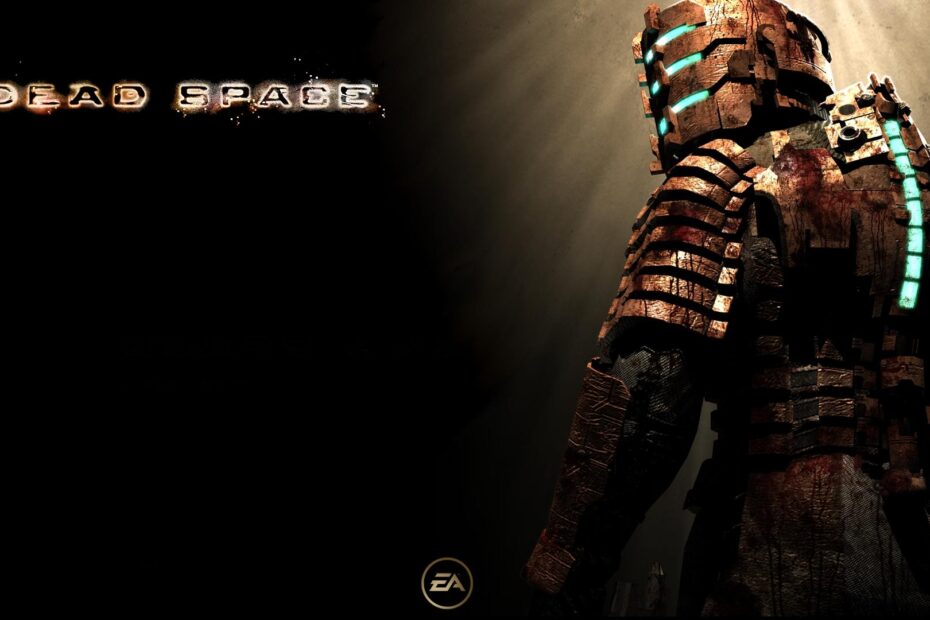“In space, no one can hear you scream”. This is especially true in Dead Space, a game so desolate you feel like the last man in the universe. Once populated by over a thousand healthy, working humans, the only remaining vestiges of life on the stout mining craft flicker momentarily before protagonist Isaac Clark, typically uttering brief words of madness before pulling the trigger aimed at their temple. Because the Ishimura isn’t humanity’s biggest accomplishment anymore, it’s their biggest nightmare. And we’re blessed with saving what’s left of it.
That’s not entirely true. When Isaac and the rest of the recon crew arrive at the freighter, survival is the immediate desperate port of call. Struck quickly with the sight of a necromorph, it’s evident the Ishimura is long gone, and just getting by will be enough of a task for the few of us that remain.
Inspired by the contemporary success of Resident Evil 4, Dead Space employs a similar control scheme and inventory management system to the horror icon. In the way of positive comparisons, Dead Space arguably plays a lot smoother than the tank-like movement found in Capcom’s classic, still retaining the same purposeful “clunk” found in that game while having a greater degree of nimbleness. It’s illustrative of the greater pace of Dead Space, as it’s one which persistently pens the player into both tight corners and semi-open arena’s where the iconic necromorphs charge you with blistering speed. It’s a notable difference, one which makes Dead Space play more frantic and less deliberate than the methodical, lumbering pace of Resident Evil 4. Despite the precise nature of Dead Space’s limb removal mechanic, it’s a game which bombards the player with terror, fueled by the swift movement of the enemy.
Dead Space is ostensibly mimicking the same vibe as Resident Evil 4 however, and that applies to the horror aspect too. Sometimes the Resident Evil franchise loses me when it comes to spooks and scares, as, like my partner points out, their creature designs have a tendency to indulge in excess, monsters which look so outrageously vile they’ve lost any human characteristics and feel akin to the same “horror” as a Saw film. Dead Space markedly isn’t that. The necromorphs, as a line of creatures, retain signs of their human husks: arms, legs, torsos and head. Only, it’s off. Their arms are twice as large, bent in all the wrong places like a spider standing upright. Legs which twist in unnatural angles. Bodies ripped open, displaying organs for all to see. Faces devoid of personality, filled with the essence of death and decay. Overall, there are a good twelve or so types in the game, identifiable each of them by their unique movement patterns and grossly distended limbs. Common slashers might swarm you in numbers, intimidating with their height, while lurkers downright terrify with their baby-like stature and cries. The pregnant burst open, releasing swarmers like a walking spider nest, guardians remotely wail at you, physically stuck to the walls, only using its lively intestines to attack you if you get too close.

Not all is lost however. Despite their terrifying designs, they have limbs, and if Dead Space is about anything, it’s about removing limbs. Sometimes your own, as the necromorphs just adore swiping your head off for fun, but with any luck and skill, you become adept at blasting their heads off before they can get to yours. The weapons in Dead Space accommodates this feature, as they clearly depict the firing lines before you shoot. The first weapon you equip for example, the plasma cutter, fires in a small but accurate straight line. You can adjust whether the gun will shoot vertically or horizontally, and by lining up the sights to a necromorphs limbs, you can slice them off, gaining the advantage in the way of actually having legs to get around. This bolsters the horror aspect in some way too, as a headless, legless and probably arseless necromorph crawling towards you, using its gangly pincers like an ice axe, truly is a sight to behold. First and foremost however, it’s superb gameplay mechanics, offering a degree of strategy behind how you survive altercations. As previously stated, the necromorphs are fast, so being capable of removing their legs might buy you some time while you deal with the lurkers sniping you from across the room. It helps that the range of necromorph enemies available is vast, as each one has a particular weakness. In the case of the boss-like hunter, removing any limb takes time due to its resilience, and even then it has the ability to regenerate limbs after a short period of time. Thus, sometimes it might be beneficial to take off its arms, reducing the damage it can deal to you while you dispatch the rest of the swarm.
It’s hard to speak of the entire arsenal though, as Dead Space doesn’t pressure the player into using certain weapons at any point throughout the game’s length, so much so I used the first two weapons the entire time. On one hand, I adore this design, the same “no weapon is better than another” philosophy proven beautifully in Dark Souls. I was able to upgrade the plasma cutter and pulse rifle to tip top shape, cutting the most limber limbs clean off with a single shot late in the game. It’s empowering in the moment, yet in retrospect it felt disappointing to be given this much freedom, as I had no motivation to even try the other weapons. This is highlighted further when you upgrade your weapons, as the means of upgrading requires a somewhat rare item, so swapping out a beefy upgraded rifle for a bog standard hand cannon is a decision I didn’t even consider. The disappointment stems from the fact I’m certain the rest of Dead Space’s arsenal is a (literal) blast to use, but due to the game’s relaxed attitude, I’ll never actually know.
Speaking of upgrades, throughout the game you can collect blueprints which, when cashed in at a store point, allow you to buy new weapons, equipment and most important of all, the suit upgrade. It’s all tied into the inventory management, and to make another comparison to Resident Evil 4, this is an area where Dead Space faltered, perhaps due to the lack of balance in the normal difficulty. Simply put, the stress of deciding what loot to take with you present in Resident Evil 4 doesn’t really exist in Dead Space. For one, the game rarely gives you ammo for weapons you’re not using, so in my case, I only ever hoarded ammo for my two guns, which was liberally dropped by enemies or stashed in lockers and crates. As a result, any remaining space tended to be taken up by a few health packs and whatever blueprint I might pick up. There’s no decision making involved really, and it makes the game feel a bit shallow in that regard. Leon Kennedy’s fight for survival had him picking up single use grenades, ammo for a multitude of weapons, herbs which only become useful combined with other herbs etc. It’s more dynamic, and combined with the novel puzzle-like way you fit stuff in your inventory it became a game in itself.
The notion of poor balance extends further into the store function, and worsens as the game progresses. Lacking a charismatic, dodgy dealer, Dead Space utilizes static store points for the player to sell, buy and stash items. For the first half of the game, I would chuck a bunch of ammo and health packs in the storage section, assuming the game would get more stringent at dishing out resources, but by the end of the game, I noticed I never once withdrew any of those items. The sell function early in let me accrue some quick, easy credits by selling ammo for guns I don’t use, along with cashing in on my surplus of health packs and other valuable junk. Again, in the latter portions of the game, any time I would even come close to needing more ammo or health, I knew I had it in storage, making the credits redundant. In another universe, where I didn’t save those items away, the amount of money I had acquired made scrounging for resources pointless as I could buy my way back into the game with ease.

An obvious response would be to up the difficulty, but you never notice it’s a problem until hours down the line. Frankly, games which default to a “normal” difficulty shouldn’t have these problems to begin with, so I don’t see it as a suitable solution anyway. Besides, other areas the game wavers in terms of challenge are inherent to the game’s design. Audio can be summarised as high quality, if frequently tacky and poorly placed. Necromorphs release ghastly gurgles fitting for the horror atmosphere. The ambient pieces of the score which play during quiet sections adds to the tension too, but on the other side of the coin exist music stings which demolish the gradually building suspense by revealing threats with blatant cues. I found this single attribute to the game’s audio not only a limiting factor in how scary the game ultimately ended up being – which frankly fell short of its contemporaries – but it also made combat encounters too easy by disclosing enemy attacks before they even strike. Sure, I don’t want to be struck blindly by a necromorph with no warning, but the harshness to Dead Space’s warning shots are so loud and blatant that it had the opposite effect. When I think of Resident Evil 4, I think of foreign cries to battle, matched with an unsettling, reserved score. Dead Space leans into its action inclinations too jarringly through it’s music, and probably exists as my least favourite part of the game due to its far reaching effects on other elements to its design.
On the topic of telegraphing combat, let’s talk about it in a more general sense. Broadly speaking, Dead Space’s relatively short length combined with its core appendage-splitting gameplay loop makes for a thoroughly enjoyable romp. The plentiful pool of necromorphs at the game’s disposal make for varied encounters, where some levels even chuck conventional movement out the window with zero gravity sections, facilitating wall running and diving through the air. There is diversity to be seen in location, and encounters which develop down hallways and other claustrophobic winding corridors build upon tension and horror, yet the game frequently damages much of that by creating large arena-style rooms which, from the very sight of them, indicate imminent combat. It wipes out any possible suspense, but I find these sections rather boring in terms of fighting too. Typically, you’ll find a safe wall to back into and have at the necromorphs as they charge at you. They’re much easier sections than the sudden corridor attacks, and without the element of surprise, the necromorphs, regardless of their type, become target dummies.
Dead Space’s premise can be viewed as a sort of homage to Alien; several humans stuck on ship and some spooky alien’s aboard. Your crew is much smaller, and playing Dead Space is more akin to playing Alien: Isolation which to no one’s surprise, deals closely with the theme of loneliness. Where Alien’s narrative involved gradual decay and paranoia, the Ishimura has collapsed, and only the recon crew of three perceptively exist. Even then, outside of the first fifteen minutes, your comrades are functionally never seen again in the flesh, both communicating to you via video link. As a result, Dead Space is fittingly dire, yet due to the lack of character and characters, paired with a lazy, ineffective means of storytelling, it fails to implement a worthwhile story. The narrative crux is escaping the ship, essentially, but the way you go about doing so feels convoluted and “gamey”: Go to this part of the ship, turn this thing on, fight enemies, now we need this thing switched off, go there etc. Moreover, much of the substance to the Ishimura’s decay relies on audio and text logs, the latter of which doesn’t suit this game at all and I ended up skipping completely, but the audio logs aren’t much better. The voice acting is generally quality – although the lack of such audio for the protagonist further proves Dead Space’s ultimate AAA “gamey-ness” – but what’s being spoken during the audio clips was shrouded in religious subtext and names without a face to attach to.
My interest in playing Dead Space can be illustrated by the way I ended up playing the game: a chapter at a time and no more. Each chapter is about 45 minutes long, and those 45 minutes are filled with tense combat, creepy visuals and a solid chunk of what appears as pandering to the common denominator. Dead Space doesn’t seem motivated in telling you a good story, nor did it do much in terms of progressing a genre Resident Evil 4 already revamped a few years prior. I couldn’t shake the comparison throughout my entire playthrough, both a compliment and a complaint. Despite my qualms, for something clearly inspired by that game, it takes a lot of what made it so brilliant and wrapped it in a neat sci-fi wrapper, and it’s worth a shot for any fan of the genre.

